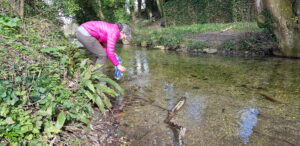by
Sara Dudman
13th May 2022
Chase & Chalke Artist in Residence Sara Dudman RWA gives us an insight into the ‘Unearthing’ project, which aims to explore Cranborne Chase through its geology and earth colours. Read more about the Chase & Chalke Artist Residencies here.

Where to begin?
With a series of **Sporadic-Nomadic** walks, learning and feeling the terrain and character of Cranborne Chase and the river valleys.
**Sporadic** because I have been coming and going from Cranborne Chase since I first arrived in early February.
**Nomadic** because that’s what I’ve become; walking the routes first laid down many centuries ago by other travellers for so many different purposes.

Cranborne Chase is so deeply rooted in its origins as a Royal Hunting Chase, and before that, as a nomadic hunting ground since Neolithic and even earlier people occupied this land.
Wherever I’ve walked, it always seems to come back to the ‘hunting’.
Picking up spent cartridges, animal bones, walking beside fields of uncut tall elephant grass, providing food and cover for today’s game birds and my own wanderings, collecting earth and rocks in recycled bread bags; I am a hunter-gatherer.
But I haven’t only been hunting for the raw materials with which I’ve been making paints and pastels. I’ve been searching out the myriad of stories which every footstep reveals, with help from wonderful volunteers who have accompanied my walks and the local knowledge of farmers, artists, and an archaeologist.

Walking is part of the work.
What is art? Giving visual form to something otherwise intangible? If that’s the answer, then how to make artwork which visualises so many intangibles which have been unearthed in the process of walking?

Earths and rocks collected during the walks are carefully labelled with the exact location and description of where they were found, resulting in a collection of wild pigments ready to be made into paints as well as pastels which now go by names such as:
**Tinkley Bottom Bunding White**
**Shire Rack Brown**
**Rat’s Castle Red**
**Swimming Pool Construction Site Grey**
**Dorset Cursus White**
**Vernditch Lodge, Sir Philip Sidney Site of Arcadia (alleged) Brown**
**Storm Eunice Felled Tree, Roman Road Ochre**
**Church Bottom Puddle **
**Prescombe Down Nature Reserve Valley Bottom Molehills Brown**

Every time I reach for a different colour, another story is woven into the work. Selecting colours also selects new narratives.
The notion of Arcadia intrigues me. Sir Philip Sidney was so moved by the beauty of the landscape around him in Cranborne Chase in the 16thC that he wrote the romantic epic known as ‘Arcadia’, in honour of his sister.
Arcadia: ‘an image or idea of life in the countryside that is believed to be perfect’
– Cambridge English Dictionary
The idea of finding Arcadia feels so very pertinent today – in the age of a pandemic, war and climate change?

All the stories and histories contained within the geology of Cranborne Chase are simply the shoulders upon which we stand today.
Human endeavours, emotions, animals, seasonal and life-cycles of plants and trees all form the next generation of the geology and land.
So, I collected botanical specimens of wildflowers and weeds growing along Shire Rack on Day 4 of the **Sporadic Nomadic** walks.
Now back in the studio I’ve been making paintings in the tradition of botanical art. Using paints and pastels created from the earths from which the plants have grown – and in turn will also become.
The short seasonal life of these apparently insignificant plants echoes the blink-of-an-eye of geological time during which this land has been occupied by us humans.

I’m enjoying the plentiful parallels between the walks and the paintings. Like cartography, botanical illustrations originated from myth and hearsay to increasingly analytical observation from direct experience.
Much of this residency has revolved around mapping. The paintings currently in progress, using celandine and wild violets as their motifs have their roots in Shire Rack. An ancient shire boundary, begun as a series of oak trees by which locals navigated and found their way through forests on their hunts.
Yes, I’m a tree-hugger!
The urge to embrace one of these mighty oaks during the walk was irresistible. Thank you trees for all you give us. Thank you to all the previous generations of travellers and hunters for finding and marking the routes.

So now I work in the studio: part-artist, part-scientist, part-geologist, part-cook, soaking, grinding, sieving, drying, mixing, pouring, making, creating, thinking, consolidating, wondering.
Each paint and pigment changes the direction of the works which reveal themselves gradually, rather like Michelangelo’s ‘Captives’ did from those mighty blocks of marble all those centuries ago.
Nothing changes. Everything changes.
Sara Dudman RWA has extensive experience of leading participatory projects and events across the South West of England, and we are delighted to have engaged her for our first Chase & Chalke Artist Residency. For more information about her work and previous projects, visit www.saradudman.com.
To follow Sara’s journey you can connect with her via social media:
Instagram: @SaraDudman1
Facebook: @SaraDudman1
